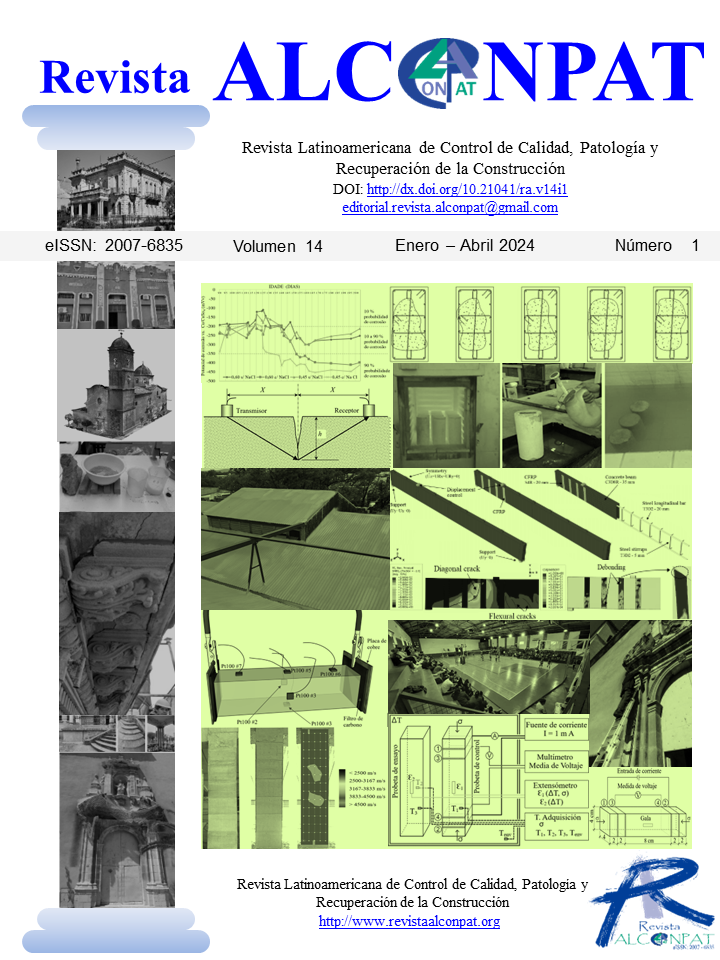Influence of temperature on the electrical resistivity of concrete and kinect corrosion of reinforcement
DOI:
https://doi.org/10.21041/ra.v14i1.709Keywords:
reinforcement concrete; durability; corrosion; electrical resistivity; temperature.Abstract
The work evaluated the influence of temperature on the concrete electrical resistivity measurements and corrosion kinetics in reinforced concrete structures subjected to chlorides. The concretes were mechanically characterized at 28 and 90 days. After 204 days, the specimens were subjected to temperature cycles ranging from 55 °C to -5 °C. The results indicated that the corrosion kinetics and electrical resistivity varied with the temperature changes. At higher temperatures, dosages contaminated with Cl- showed a high probability of corrosion and a decrease in electrical resistivity values, however, at negative temperature, the probability of corrosion was insignificant and the electrical resistivity values were the highest.
Downloads
References
Alhozaimy, A., Hussain, R., Al-Negheimish, A., Al-Zaid, R., Singh, D. (2014), Effect of simulated concrete pore solution chemistry, chloride ions, and temperature on passive layer formed on steel reinforcement. ACI Materials Journal. American Concrete Institute. v. 111, n. 4, p. 411-421. https://doi.org/10.14359/51686829
American Association of State Highway and Transportation Officials (2015). T 358 – 15. Surface Resistivity Indication of Concrete’s Ability to Resist Chloride Ion Penetration. Washington.
Al-Khaja, A. W. (1997), Influence of temperature, cement type and level of concrete consolidation on chloride ingress in conventional and high-strength concretes. Construction and Buildings Materials, v. 11, n. 1, p. 9-13. https://doi.org/10.1016/S0950-0618(97)00004-4
American Society for Testing and Materials (2015), ASTM C 876. Standard test method for half cell potential of uncoated reinforcing steel in concrete. Philadelphia.
American Society for Testing and Materials (2017), ASTM G1-03. Practice for Preparing, Cleaning and evaluating corrosion test specimens. Philadelphia.
American Society for Testing and Materials (2019), ASTM C215. Standard test method for fundamental transverse, longitudinal, and torsional resonant frequencies of concrete specimens. Philadelphia.
Andrade, C. Feliu, S. (1988), Manual de inspección de obras dañadas por corrosión de armaduras. Madrid: CSIC/IETcc. 122 p.
Andrade, C.; Carruyo, A. R.; Dias, J.; Helene, P. R. L.; Rincon, I. T. (1997), Manual de inspección, evaluación y diagnóstico de corrosión em estructuras de hormigón armado. DURAR (Red Temática XV.B – Durabilidad de la armadura – del programa ibero-americano de ciência y tecnologia para el desarrollo) Rio de Janeiro: CYTED. 208p.
Associação Brasileira De Normas Técnicas (2018), NBR 16697. Cimento Portland - Requisitos. Rio de Janeiro.
Associação Brasileira De Normas Técnicas (2005), NBR 9778 Versão corrigida 2: 2009. Argamassa e concreto endurecidos – Determinação da absorção de água, índice de vazios e massa especifica. Rio de Janeiro.
Associação Brasileira De Normas Técnicas (2018), NBR 5739. Concreto ensaio de compressão de corpos de prova cilíndricos. Rio de Janeiro.
Associação Brasileira De Normas Técnicas (2015), NBR 5738. Concreto – Procedimento para moldagem e cura de corpos de prova. Rio de Janeiro.
Bungey, J.H.; Millard, S. G. (1996), Testing of concrete in structures. 3 ed. S.l: Chapman & Hall, 226p.
Chauhan, A.; Sharma, U. K. (2019), Influence of temperature and relativity humidity variations on non-uniform corrosion of reinforced concrete. Structures. v. 19, p 296-308. https://doi.org/10.1016/j.istruc.2019.01.016
Figueiredo, E. J. P.; Meira, G. (2013), Corrosión de armadura de estructuras de hormigón. Boletín Técnico 06. ALCONPAT International. México. 32p.
Figueiredo, E. J. P. (2005), Efeitos da Carbonatação e de Cloretos no Concreto. In: ISAIA, G. C. (Ed.). Concreto: Ensino, Pesquisa e Realizações. Vol. 2. Cap. 27. São Paulo: IBRACON, p. 829-855.
Gjørv, O. E. (2015), Projeto da durabilidade de estruturas de concreto em ambientes de severa agressividade. São Paulo: Oficina de textos. p.238.
Helene, P. R. L. (1993), Contribuição ao estudo da corrosão em armaduras de concreto armado. 231 p. Tese de Livre Docência. Escola Politécnica, Universidade de São Paulo (USP), 1993.
Melo, G. F.; Laurentino, J. V. A.; Santos, L. O. (2021), Estudo comparativo das eficiências de agentes inibidores comerciais de corrosão em estruturas marítima de concreto armado. Engineering Sciences, v.9. n.2. p.66-80.
Medeiros-Junior, R. A. de, Munhoz, G. da S., Medeiros, M. H. F. de. (2019). Correlación entre la absorción de agua, la resistividad eléctrica y la resistencia a la compresión del hormigón con diferentes contenidos de puzolana. Revista ALCONPAT, 9(2), 152 - 166. https://doi.org/10.21041/ra.v9i2.335
Mendes, S.E.; Oliveira, R.L.; Cremonez, C.; Pereira, E.; Pereira, E.; Medeiros-Junior, R.A. (2018), Electrical resistivity as a durability parameter for concrete design: Experimental data versus estimation by mathematical model. Construction and Building Matererials. 192 p. 610–620.
Michel, A.; Sørensen, H.E.; Geiker, M.R. (2021), 5 years of in situ reinforcement corrosion monitoring in the splash and submerged zone of a cracked concrete element. Construction and Building Materials. v. 285. 12 p. https://doi.org/10.1016/j.conbuildmat.2021.122923
Noort, R.; Hunger, M.; Spiesz, P. (2016), Long-term chloride migration coefficient in slag cement-based concrete and resistivity as alternative test method. Construction and. Building. Materials. 115, 746–759. https://doi.org/10.1016/j.conbuildmat.2016.04.054
Østvik, J. M. (2005), Thermal Aspects of corrosion of steel in concrete, PhD Thesis. Departament of Structural Engineering, Norwegian University of Science and Technology – NTNU, Trondheim.
Raphael, M.; Shalon, R. (1971), A study of the influence of climate on corrosion and reinforced concrete. In: RILEM Symposium on Concrete and Reinforced Concrete in Hot Climates, Proceedings. p. 77-96.
Torres, A. S. (2011), Corrosão por cloretos em estruturas de concreto armado: uma meta-análise. Porto Alegre. 170p.
Tuutti, K. (1982), Corrosion of steel in concrete. Sweden: CBI. 468 p.
Wolynec, S. (2002), Técnicas Eletroquímicas em Corrosão. EDUSP, São Paulo.
Wosniack, L. M.; Real, L. V.; Silva, M. D.; Macioski, G.; Hoppe Filho, J.; Medeiros, M. H. F. (2021), Resistividade elétrica do concreto pelo ensaio de migração de cloretos: comparação com o método dos quatro eletrodos. Ambiente Construído, Porto Alegre, v. 21, n. 3, p. 321-340, jul./set.ANTAC.
Yousuf, F.; Wei, X.; Tao, J. (2017), Evaluation of the influence of a superplasticizer on the hydration of varying composition cements by the electrical resistivity measurent method. Construction and Building Materials. P.25-34. https://doi.org/10.1016/j.conbuildmat.2017.03.138
Published
How to Cite
Issue
Section
License
_______________________________
License in effect from September 2020
You are free to:
- Share — copy and redistribute the material in any medium or format for any purpose, even commercially.
- Adapt — remix, transform, and build upon the material for any purpose, even commercially.
- The licensor cannot revoke these freedoms as long as you follow the license terms.
Under the following terms:
- Attribution — You must give appropriate credit , provide a link to the license, and indicate if changes were made . You may do so in any reasonable manner, but not in any way that suggests the licensor endorses you or your use.
- No additional restrictions — You may not apply legal terms or technological measures that legally restrict others from doing anything the license permits.
Notices:
You do not have to comply with the license for elements of the material in the public domain or where your use is permitted by an applicable exception or limitation .
No warranties are given. The license may not give you all of the permissions necessary for your intended use. For example, other rights such as publicity, privacy, or moral rights may limit how you use the material.





















.png)














